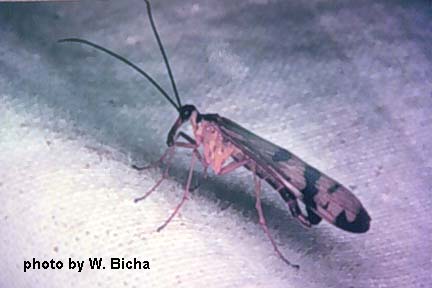|
||||
|
ENTOMOLOGY
RESOURCES
|
| ARACHNIDA |
EMBIIDINA |
FOSSIL INSECTS |
HYMENOPTERA |
MECOPTERA -World Checklist of Extant Mecoptera Species -World Mecoptera Bibliography |
NEUROPTERA |
MECOPTERA

WORLD CHECKLIST OF EXTANT MECOPTERA SPECIES
Mecoptera represent one of the major basic lineages of holometabolous insects. They are most often defined by the characters they do not possess. Hindwings are not modified into small halteres, as in Diptera. Forewings are not modified into sclerotized wing covers, as in Coleoptera. Wings are not covered with hairs or scales, as in Trichoptera and Lepidoptera. Their bodies are not strongly flattened and sclerotized for an ectoparasitic mode of existence, as in fleas. Forewings are similar in size and shape, unlike Hymenoptera. Wings usually do not have reticulate venation, with apical forks and twiggings, as in Neuroptera and Megaloptera. The thorax is not elongate, as in Raphidioptera (snake-flies). However, many of the modern families of Mecoptera have the mouthparts extended into an elongate rostrum. Even though these differences occur, several of these groups probably shared a common ancestor with Mecoptera. Because of this lack of defining, unifying characters for all Mecoptera and the basal relationships with so many other orders, the Mecoptera are almost certainly not a monophyletic group as currently defined and will probably eventually be redefined as several groups.
Today mecopterans represent no more than one one-hundredth of one percent
of living species, but in the Permian fossil beds of Elmo, Kansas they
accounted for 40% of known fossils. The remnant fauna existing today is
quite diverse in life history, as might be expected from more than 200
million years of evolution.
This list of mecopterans (scorpion-flies and hanging-flies) is being placed
on the internet as a reference resource to the biological community and
curious naturalists. It is an updated version of the world checklist published
by Penny & Byers (1979). Most references are completely cited in Schlee
(1976). State abbreviations for Brazil, Canada, and U.S.A. use their respective
official postal codes. An attempt will be made to keep it current.
This bibliography is being placed on the California Academy of Sciences server as a research reference tool to be used by systematists in studying the biodiversity of this order of insects. An attempt will be made to keep this list current, although this will be done only as time permits. This list is an updated, electronic version of the world list of Mecoptera references published by Schlee and Schlee (1976). The reference numbers under 30,000 with each citation pertain to John Oswald's World Bibliography of Neuropterida [at www.tamu.edu/neuroweb/]. These Mecoptera/Neuroptera references often contain addtional information on date of publication. Reference numbers over 30,000 are unique to the Mecoptera. I wish to thank Pierre Tillier for bringing to my attention many of the most recent references.




